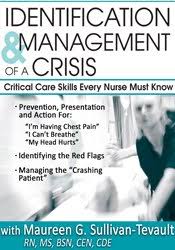Identification & Management of a Crisis: Critical Care Skills Every Nurse Must Know – Sandy A Salicco | Available Now !
$199.00 Original price was: $199.00.$56.00Current price is: $56.00.
Identification & Management of a Crisis: Critical Care Skills Every Nurse Must Know – Sandy A Salicco | Instant Download !
Sale Page_https://catalog.pesi.com/item/16674/
Archive: https://archive.fo/cVsnN
Mrs. Kelp is admitted to your floor with pneumonia and an exacerbation of COPD. Twenty minutes after admission, she develops worsening dyspnea and hypotension.
Are you prepared to manage her unstable condition?
Do you know what respiratory measures are necessary?
Do you know the best way to manage her hypotension?
The patients in our hospitals are sicker than ever before. It is not uncommon to find patients on regular medical floors with central lines, chest tubes, pacemakers and AICDs. Some nursing homes are accepting patients on ventilators, and patients are now being sent home on vasoactive drips such as dobutamine. Even though acuity levels are higher, you are still caring for many patients and don’t have the luxury of frequent, comprehensive assessments. Therefore, it is important to be able to rapidly assess and implement appropriate interventions. Attend this seminar to sharpen your skills and leave prepared to identify and manage your next patient emergency!
OUTLINE
IDENTIFYING THE RED FLAGS
- Critical Thinking During a Crisis
- Rapid Assessment Techniques
- ABCD in Less Than 10 Seconds
- Critical Questions to Ask Your Patient
CARDIOVASCULAR
Prevention, Presentation, Action for: “I’m Having Chest Pain”
- Recognizing Arrhythmias
- Stable, Unstable and Lethal
- 12-Lead EKG: Just the Down and Dirty
- Utilizing a Systematic Approach
- Patterns of Ischemia, Injury & Infarct
- Acute Myocardial Infarction: STEMI/NSTEMI
- Key Assessments & Interventions
- tPA Guidelines
- Cath Lab Intervention
- Heart Failure
- Recent Advances in Care
- Medication Management
- Fluid Restriction
RESPIRATORY
Prevention, Presentation, Action for: “I Can’t Breathe”
- Assessment & Intervention
- Anxiety vs. Respiratory Symptoms
- The Patient Who Needs Assistance
- O2, CPAP, BiPAP
- Indications for Intubation
- Positive Pressure Ventilation
- Respiratory Syndromes
- Spontaneous Pneumothorax
- Chest Tube Management
- COPD
- Presentation: Why the Pursed Lips & Barrel Chest
- PROACTIVE not Reactive Interventions
- Respiratory Failure
- Ventilator Settings Every Nurse Must Know
- Spontaneous Pneumothorax
NEUROLOGICAL
Prevention, Presentation and Action for: “My Head Hurts!”
- Elevated Intracranial Pressure
- Clues When you Don’t have a Monitor
- Ischemic vs. Hemorrhagic Stroke
- Inclusion/Exclusion for tPA
- Essential Assessments post-tPA
MANAGING THE DECOMPENSATING PATIENT
Prevention, Presentation and Action for: “The Crashing Patient”
- Anaphylaxis
- Sepsis
- Shock
- Considerations for Transport
- Activating the Rapid Response Team
OBJECTIVES
- Describe two types of rapid assessment techniques and how to employ them for the best results during a patient emergency.
- Evaluate techniques for getting critical information during a rapid patient assessment.
- Recognize EARLY assessment findings in clinical syndromes that may progress rapidly and cause life-threatening conditions.
- Prioritize nursing actions for specific neurological, cardiac, respiratory and endocrine emergencies.
- Review care of the diabetic patient in diabetic ketoacidosis versus HHNK/HHS. Differentiate key differences in presentation, lab results and plan of care.
- Define heat failure with regards to left- and right-sided failure; discuss treatment options, acute and follow-up care.
- Discuss critical interventions and review treatment options for Sepsis and Shock.
Tag: Identification & Management of a Crisis: Critical Care Skills Every Nurse Must Know – Sandy A Salicco Review. Identification & Management of a Crisis: Critical Care Skills Every Nurse Must Know – Sandy A Salicco download. Identification & Management of a Crisis: Critical Care Skills Every Nurse Must Know – Sandy A Salicco discount.
1 review for Identification & Management of a Crisis: Critical Care Skills Every Nurse Must Know – Sandy A Salicco | Available Now !
Add a review Cancel reply
Related products
Ecommerce
NLP & Hypnosis
NLP & Hypnosis
Ecommerce
NLP & Hypnosis
Ecommerce
Ecommerce












Angel Galloway –
Great communication. | Identification & Management of a Crisis: Critical Care Skills Every Nurse Must Know – Sandy A Salicco